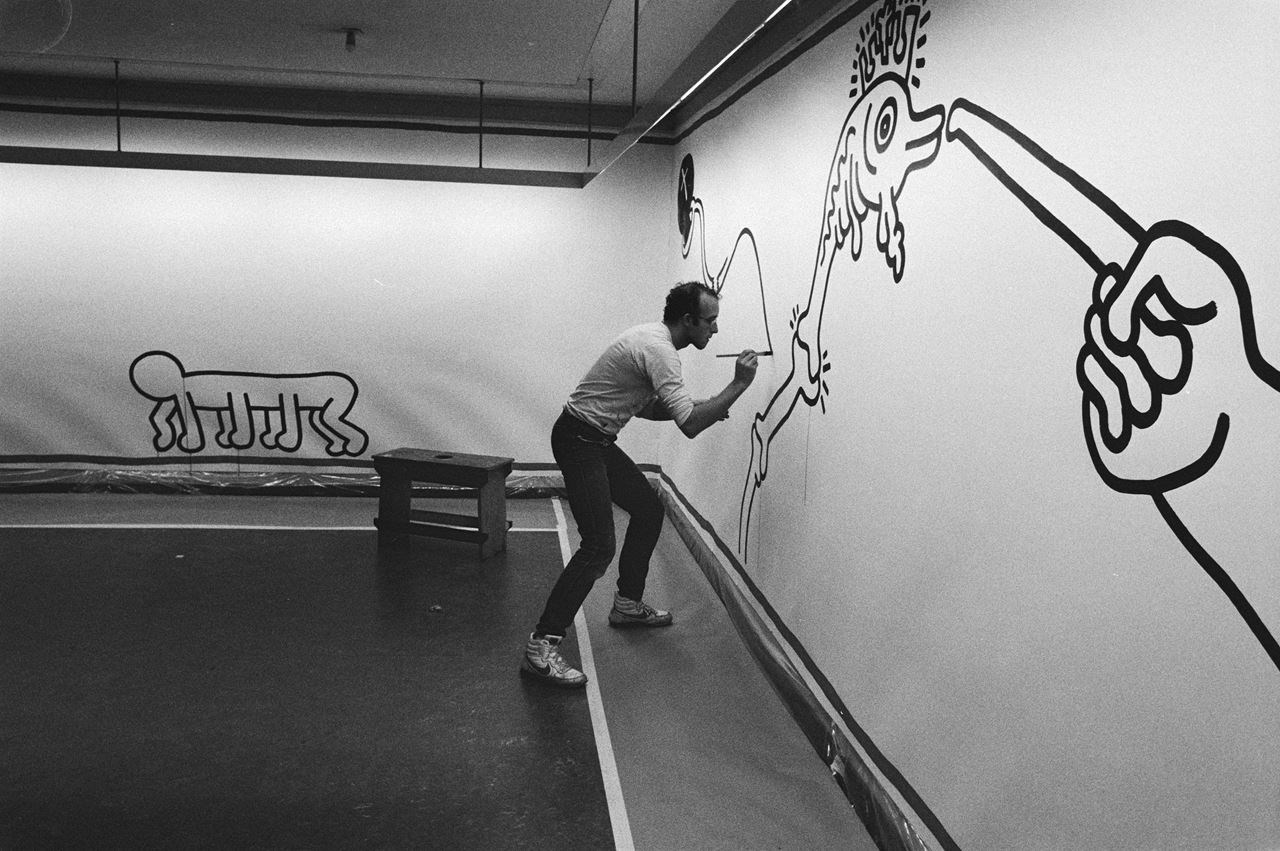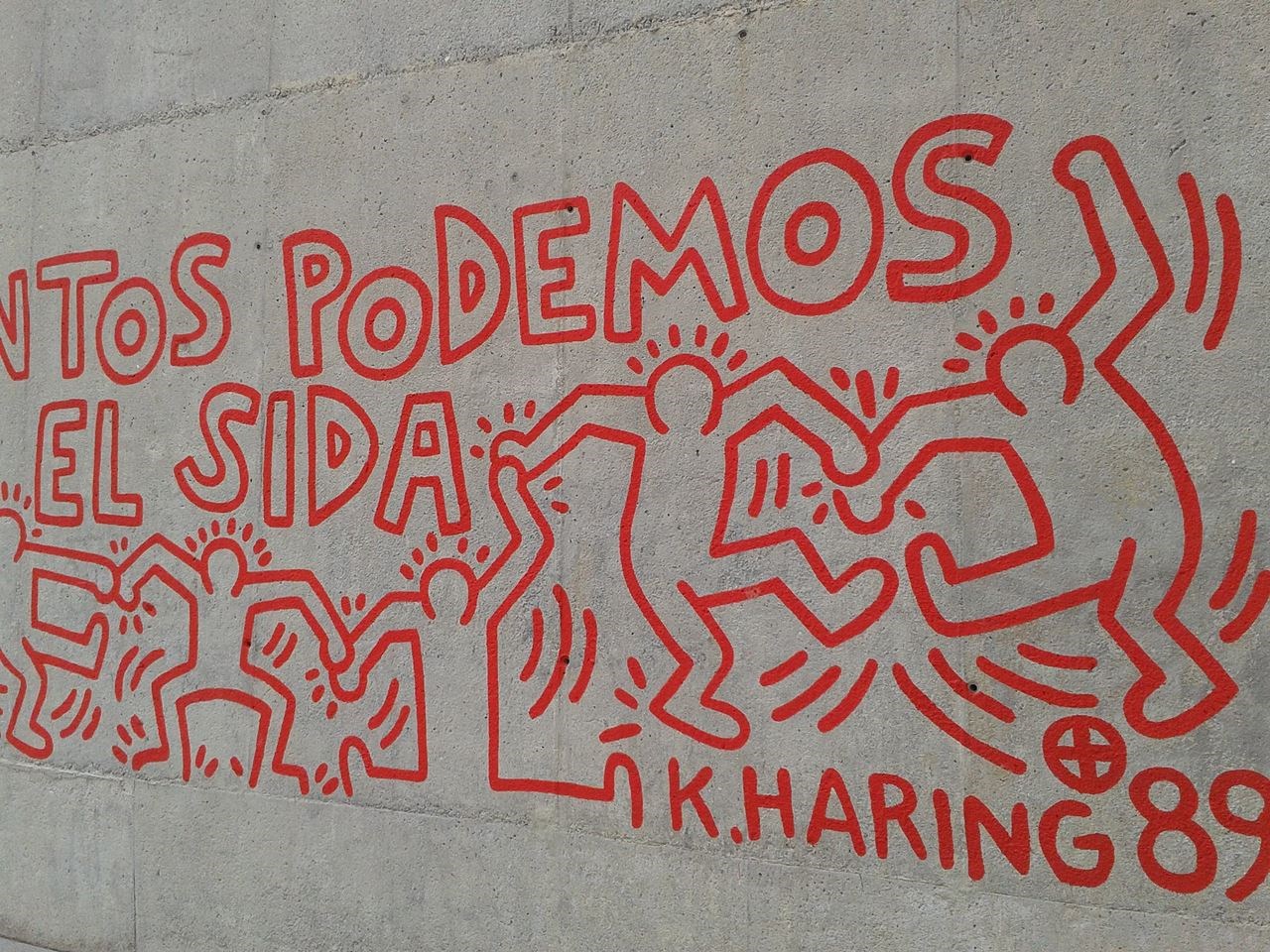“There is nothing negative about a baby, ever.”
-Keith Haring
 Keith Haring creating one of his famous muralsNationaal Archief [CC BY 4.0 (https://creativecommons.org/licenses/by/4.0)]What makes a hero? Dedication. Attitude. Persevering through adversity. When I think of these traits one name comes to mind: Keith Haring. Before he was an icon, Haring came from a small town. He was born on May 4th, 1958, in Reading Pennsylvania to Joan and Allen Haring. Throughout the beginning of his life, he was artistically inclined with inspirations including Walt Disney, Dr. Seuss, and his father. As Haring transitioned into high school, he realized he had wanted to pursue a career in art. Haring's father and school counselor had convinced him to attend the Ivy School of Professional Art located in Pittsburgh. He soon realized that commercial art and illustration wasn't suited for him, he believed that his art would be lost, so he left the school and ventured off to New York to pursue his dream of becoming an artist. Once reaching New York City, Haring then attended the School of Visual Arts where he met a good friend Kenny Scharf. In 1979, Haring and Scharf, along with Ann Magnuson, organized art parties which were a mix of comedy skits, performances, and visual art. This helped boost Haring's popularity and his artwork was sought after meeting Tony Shafrazi, an owner of an art exhibit who allowed him to freely express his art without repercussions.
Keith Haring creating one of his famous muralsNationaal Archief [CC BY 4.0 (https://creativecommons.org/licenses/by/4.0)]What makes a hero? Dedication. Attitude. Persevering through adversity. When I think of these traits one name comes to mind: Keith Haring. Before he was an icon, Haring came from a small town. He was born on May 4th, 1958, in Reading Pennsylvania to Joan and Allen Haring. Throughout the beginning of his life, he was artistically inclined with inspirations including Walt Disney, Dr. Seuss, and his father. As Haring transitioned into high school, he realized he had wanted to pursue a career in art. Haring's father and school counselor had convinced him to attend the Ivy School of Professional Art located in Pittsburgh. He soon realized that commercial art and illustration wasn't suited for him, he believed that his art would be lost, so he left the school and ventured off to New York to pursue his dream of becoming an artist. Once reaching New York City, Haring then attended the School of Visual Arts where he met a good friend Kenny Scharf. In 1979, Haring and Scharf, along with Ann Magnuson, organized art parties which were a mix of comedy skits, performances, and visual art. This helped boost Haring's popularity and his artwork was sought after meeting Tony Shafrazi, an owner of an art exhibit who allowed him to freely express his art without repercussions.
At age 29, Haring was diagnosed with AIDS, in 1989. To eliminate the stigma surrounding AIDS, Haring created the Keith Haring Foundation. He spent his last years educating children and creating murals for schools all over New York City. ("Keith Haring." UXL Biographies) (“Bio” Keith Haring Foundation). Keith Haring is a hero because he evidently remained humble with his surrounding fame. Haring is a hero to me because of his hard work and dedication to his cause, as well as his foundation to support those with AIDS, and to educate children about the disease.
UXL Biography explains how Haring dedicated his last years to ending the stigma surrounding AIDS/HIV and educating kids and teaching art to disadvantaged kids during his last years. “ After learning that he himself had the AIDS virus...He was open about his condition and met with groups of children to help educate them about AIDS”("Keith Haring." UXL Biographies). During this time, Haring used his platform to help end the stigma surrounding HIV/AIDS. People respected his ability to be open with his disease and educate those around him. He didn’t let his illness stop him, and he continued to persist through his struggles with the same positive attitude as he would with his art. “Haring was as committed to charities and social causes as he was to his brilliant self-marketing, and his seemingly naive, childlike images often had a political subtext …Other seemingly innocent drawings included messages about social violence or indifference, racism, and approaching apocalypse (end of the world). ‘I have strong feelings about the world,’ he said. ‘I want my art to make people think.’"("Keith Haring." UXL Biographies).
In Haring’s work, he always includes a statement about something, it always meant something. The main goal that he wanted to reach throughout his art was to make people think, and think about their decisions that can affect others. Harings’ political subtext throughout his artwork touches sensitive issues in a subtle and meaningful way. According to UXL Biographies, Haring was fascinated by the graffiti art culture in New York City. ”By 1979 Haring had become captivated by subway graffiti. Its raw energy and sense of color and life pleased his growing pop-art sensibilities. Haring was as committed to charities and social causes as he was to his brilliant self-marketing, and his seemingly naive, childlike images often had a political subtext.” ("Keith Haring." UXL Biographies). His interest in street art and graffiti allowed him to express his feelings and opinions towards political issues while also doing something he loved. Haring's commitment towards charities, as well as social issues, inspired him to create his own charity, The Keith Haring Foundation, which benefited those suffering from HIV/AIDS while also supporting the LGBT community. The political subtext hidden in his childlike artwork always mentioned a political issue affecting the world. In the UXL Biography, it includes how Haring met with children to educate about HIV/AIDS they wrote, “He was open about his condition and met with groups of children to help educate them about AIDS. ‘The hardest thing is just knowing that there's so much more stuff to do,’ he said. ‘I'm so scared that one day I'll wake up and I won't be able to do it.’ Haring continued to work until just a few weeks before his death on February 16, 1990, painting murals, making giant sculptures for public spaces and playgrounds, and teaching art to disadvantaged youths”. ("Keith Haring." UXL Biographies).
Though Haring was scared of his demise due to his condition, he still persisted with a positive attitude and continued the rest of his life educating those less educated on AIDS. Haring's admirable attitude allowed him to spend the rest of his life teaching art to kids, creating murals, and sculptures to inspire creativity in kids. Haring’s admirable dedication to his art, as well his charities and foundations, have inspired thousands of people all around the world to donate to charities committed to finding a cure for HIV/AIDS. Though Haring's devotion to his foundation inspired thousands, so has his artwork. His artwork provoked creativity in disadvantaged kids through his murals, sculptures, and classes committed to teaching underprivileged art to kids is an honorable act of selflessness.
Keith Haring's dedication to spreading positivity and political messages throughout his artwork. UXL Biographies describes Haring's life as a child, ”Haring was as committed to charities and social causes as he was to his brilliant self-marketing, and his seemingly naive, childlike images often had a political subtext … Other seemingly innocent drawings included messages about social violence or indifference, racism, and approaching apocalypse (end of the world). "I have strong feelings about the world," he said. ‘I want my art to make people think.’("Keith Haring." UXL Biographies) In Haring’s work, he always includes a statement about something, it always meant something. The main goal that he wanted to reach throughout his art was to make people think, and think about their decisions and how they can affect others. Harings’ political subtext throughout his artwork touches sensitive issues in a subtle and meaningful way.
UXL Biographies expresses Haring's first experience in pop art.’ I bought a roll of oak-tag paper and cut it up and put it all over the floor and worked on this whole group of drawings. The first few were abstracts, but then these images started coming... I remember trying to figure out where this stuff came from, but I have no idea. It just grew into this group of drawings. I was thinking about these images as symbols, as a vocabulary of things. In one a dog’s being worshipped by these people. In another one, the dog is being zapped by a flying saucer. Suddenly it made sense to draw on the street because I had something to say.’(“Beginnings” Keith Haring Foundation ). Haring had always had the vision to spread his work, he felt as if he couldn't perform in a secluded space as he was forced to when he went to school for graphic design. Because of this, he moved his work outside and onto sidewalks and subway walls. Haring had something to say through his art, his message was always positive and moving, whether it be about politics, societal norms/expectations, race or religion. Everything he made had a story. Haring's messages found in his artwork always took some deeper thoughts, but it always meant something valuable, whether it be about social issues, politics, racism, or his own struggles with AIDS. From a young age, Haring was dedicated to his future and career in becoming an artist. In him traveling to New York City changed his life and it allowed him to pursue street art and graffiti.
 Harings famous mural Keith Haring [Public domain]Haring's heroic character emulates through his actions of staying humble throughout his reigning fame, dedication to promoting positive political messages pertaining to racism, social issues, and inequality. He spent his last years putting his effort towards his foundation, while also spending his last years educating children about the disease. Keith Haring's dedication to his artwork, aspirations, and foundations that fund research for HIV/AIDS, LGBT issues and causes. I find this inspiring as someone who loves art and can find comfort through Haring's art. Haring's artwork has inspired plenty of people, including myself, to delve into other mediums of art and find meaning through art, while putting meaning into my own art.
Harings famous mural Keith Haring [Public domain]Haring's heroic character emulates through his actions of staying humble throughout his reigning fame, dedication to promoting positive political messages pertaining to racism, social issues, and inequality. He spent his last years putting his effort towards his foundation, while also spending his last years educating children about the disease. Keith Haring's dedication to his artwork, aspirations, and foundations that fund research for HIV/AIDS, LGBT issues and causes. I find this inspiring as someone who loves art and can find comfort through Haring's art. Haring's artwork has inspired plenty of people, including myself, to delve into other mediums of art and find meaning through art, while putting meaning into my own art.
How is Keith Haring a hero? What makes him heroic? Haring’s heroism is shown through his persistence and dedication through hardships of being unsure as to what to do with his life, to battling AIDS. Though his last years of battling his illness were filled with suffering, he persevered and continued to stay optimistic and spent the last leg of his life educating children about HIV/AIDS and ending the stigma surrounding the disease, while also teaching art to disadvantaged kids, and creating artwork for playgrounds and schools. Keith Haring's dedication, compassion is why he is a hero to me, and thousands of others.
Works Cited
Haring, Keith. “Beginnings | Keith Haring.” Beginnings | Keith Haring, 2019, www.haring.com/!/about-haring/beginnings#.XMtmTOipGUl.
“Keith Haring.” Bio | Keith Haring, The Keith Haring Foundation, 2019, www.haring.com/!/about-haring/bio#.XMoTfOipGUk.
"Keith Haring." UXL Biographies, UXL, 2011. Student Resources In Context, https://link.galegroup.com/apps/doc/EJ2108100987/SUIC?u=powa9245&sid=SUIC&xid=ceb2be40. Accessed 30 Apr. 2019.
Page created on 5/13/2019 10:03:34 PM
Last edited 5/15/2019 5:39:36 PM
